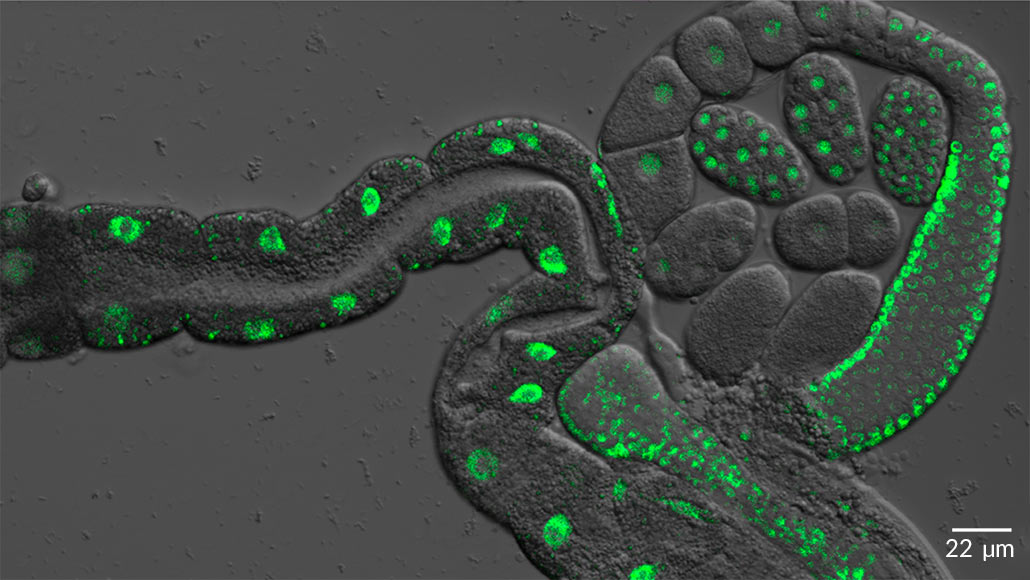
TRADE-OFF BROKER A protein called TCER-1 (green, seen in a microscope image in the gut and reproductive cells of a worm) helps strike a balance between immunity, fertility and longevity in nematodes.
F. Amrit and A. Ghazi/Univ. of Pittsburgh
- More than 2 years ago
Long life and good health don’t always go hand in hand.
A gene that lengthens nematode worms’ lives and is necessary for reproduction also makes the worms more susceptible to infection and stress, researchers report July 17 in Nature Communications. That’s unusual; longevity-promoting genes generally help organisms deal with stress, says Arjumand Ghazi, a geneticist who studies aging at the University of Pittsburgh.
Ghazi and colleagues had previously found that a gene called TCER-1 increases life span and is needed for Caenorhabditis elegans worms to produce eggs and healthy offspring. She and colleagues expected that deleting the gene would make the worms prone to infections. Instead, worms missing TCER-1 fought off a bacterial infection for nearly twice as long as worms with an intact gene, says Francis Amrit, a molecular biologist in Ghazi’s lab. “When I first saw that, I thought I’d made a mistake,” Amrit says.
The team also found that worms that made more of the TCER-1 protein than usual were able to overcome declines in fertility caused by exposure to a pathogen, but succumbed to infection faster. Those results indicate that when functioning normally, the gene helps suppress immune responses so more resources can be used for reproduction.
“In a lot of ways, reproduction and longevity are opposite one another, and this is underscored by these findings,” says Coleen Murphy, a biologist at Princeton University not involved in the work.
Worms missing TCER-1 were also resistant to other types of environmental stress, such as heat and radiation. It took about 95 hours for worms missing the gene to suffer paralysis caused by clumping of an Alzheimer’s disease protein, while paralysis started at about 33 hours in worms with the gene. Those advantages continued only as long as worms were of egg-laying age. Older C. elegans were equally susceptible to infection or stress regardless if they had the gene. All together, the results indicate that TCER-1 helps regulate survival — balancing stress responses, reproduction and life span, Amrit says.
Organisms balance survival and reproduction all the time. Animals under stress, for example, must deal with that stress and tend to stop reproducing until things get better. TCER-1’s protein works with other proteins to achieve that balance, the researchers found. Details of how the TCER-1 protein senses stress and regulates fertility, longevity and stress responses are still unknown.
While people also have a version of the gene, the work is unlikely to affect human health any time soon. But the findings could be warning bells for researchers developing antiaging therapies, says aging researcher Shin-Ichiro Imai of Washington University School of Medicine in St. Louis.
“What they demonstrate here is an important caution,” says Imai, who was not involved in the study. Antiaging therapies seem to work well, but may lead to unexpected frailty, he says. For instance, caloric restriction — eating a minimal amount of calories, but optimizing nutrition — extends life spans in a wide variety of animals, but also makes mice more susceptible to viral infections, he says. “It’s important to understand the whole dynamics of the system. You never know where frailty may pop up,” he says.






